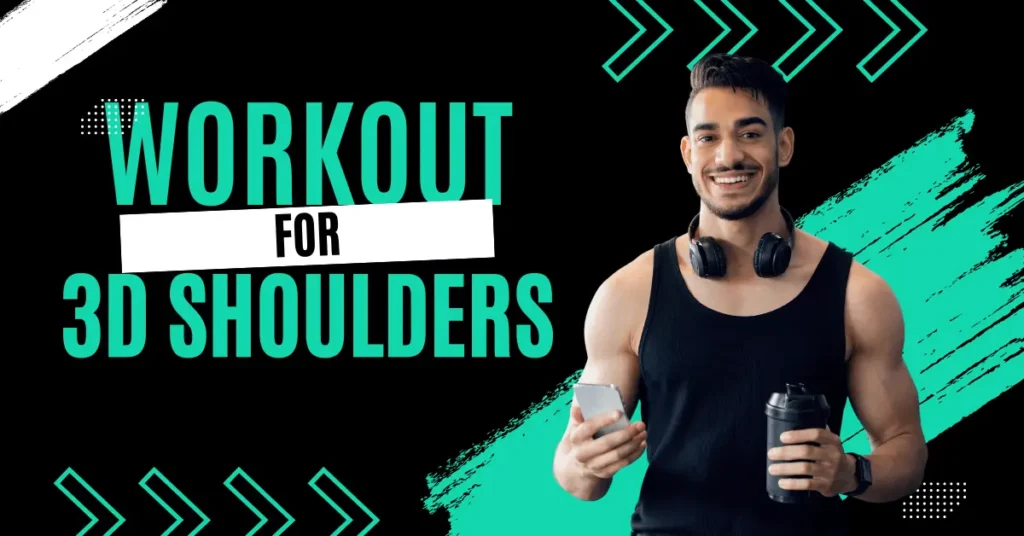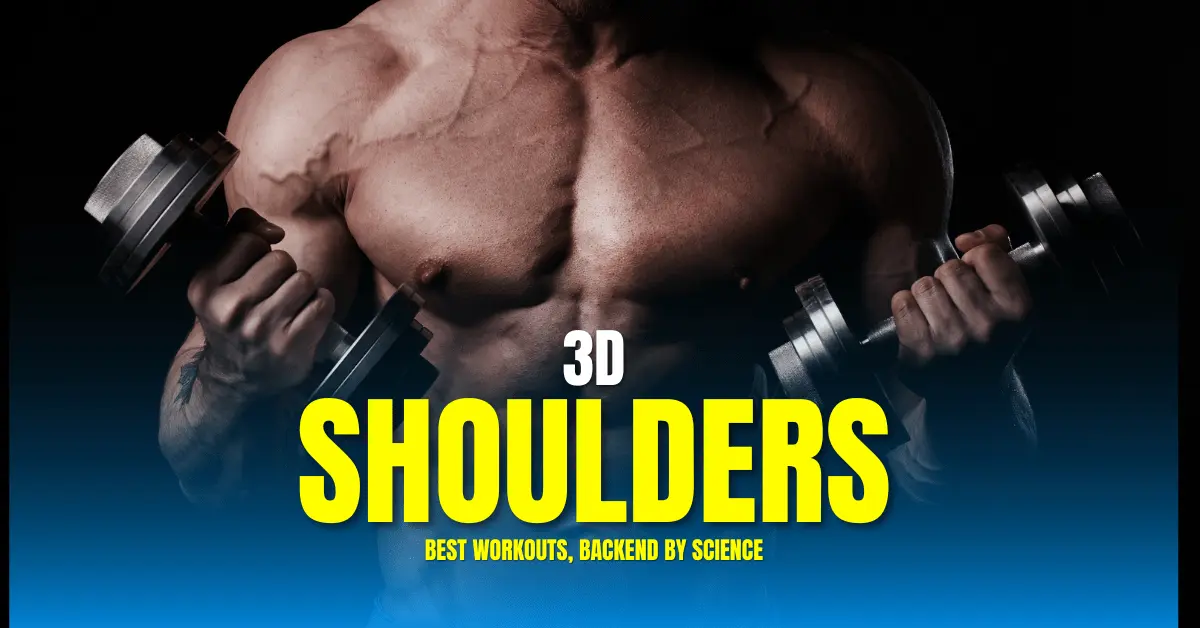You must have seen those 3D shaped round shoulders that many body builder flaunts, and of course they look cool enhances overall upper body aesthetics. But if you also like them and want to develop one then you are at the right place because we will take a complete look at the best shoulder workout for delts.
For 3D round shoulders, training all three heads of the deltoid muscle is essential. That means working the:
- Front delts (anterior)
- Side delts (lateral)
- Rear delts (posterior)
In this blog, we will discuss each and everything you need to know about delts and break down the most effective shoulder exercises for each deltoid head with insights from science-based trainers Jeff Nippard and Dr. Mike Israetel, a renowned exercise scientist. Eventually these exercises will help you get big, wider, stronger and more defined shoulders that will have strength and of course looks.

Why You Need a Complete Deltoid Routine
The first thing you need to understand is that the deltoid is not a single piece of muscle, it’s actually a trio of interconnected heads that contribute to nearly every upper-body movement. Look you must not neglect any part of the deltoid complex otherwise it may lead to muscular imbalances, shoulder instability, and a flat looking physique.
- Front delts are activated heavily during most chest presses.
- Side delts give your shoulders that wide, “capped” look.
- Rear delts enhance posture, balance your physique, and stabilize the shoulder joint.
Unfortunately, many lifters unintentionally overtrain their front delts and ignore the rear and side heads. That’s why a balanced shoulder workout is key and this guide gives you the best of the best.
Best Front Delt Exercises
Machine Shoulder Press (Jeff Nippard’s Pick)
It’s a staple compound movement that actually prioritizes the front delts while keeping everything in control and make sure a strong stability. Being seated ensures more tension on the targeted muscle group and significantly reduces the involvement of the lower-back.
Benefits:
- Provides excellent overload for growth
- Reduces injury risk with added stability
- Great for going close to failure safely
- Unilateral versions can fix left/right imbalances
Alternative: Seated dumbbell press (still great for isolation and muscle control)
EZ-Bar Front Raise (Dr. Mike Israetel’s Pick)
It’s a powerful and quite rare isolation exercise for anterior delts, this exercise offers a full range of motion and most of the finest stretch at the bottom.
How to Do It:
- Keep your arms straight (no elbow bend)
- Use light-to-moderate weights
- Control the negative for 4–5 seconds
- Perform 10–20 reps with good form
Why It Works:
While other exercises like overhead press that engages chest and triceps, this particular exercise hits the front delts directly without the much help of the surrounding muscles group. It’s one of the finest exercises for those who are dealing with pressing fatigue or shoulder joint irritation.
Best Side Delt Exercises (The Key to 3D Shoulders)
Super ROM Lateral Raise (Dr. Mike’s Top Pick)
The super range of motion (ROM) lateral raise emphasizes lifting past shoulder level, maximizing the activation of the side delts — the most visually impressive part of the shoulder.
Why It’s So Effective:
- Targets the medial deltoid with laser focus
- Helps achieve that wide, athletic shoulder look
- Works best with higher reps (10–20 range)
Pro Tip: Keep pinky fingers slightly higher than your thumbs to align resistance with side delt fibers. Avoid shrugging or swinging.
Crossbody Cable Lateral Raise (Jeff Nippard’s Favorite)
This exercise offers a great stretch and constant tension, all credit goes to the cable’s angle. It’s one of the most underrated shoulder isolation exercises, you should give it a try.
Execution:
- Position the cable low and pull diagonally across your body
- Keep your torso stable and don’t let momentum take over
- Use a “sword-draw” motion to activate unique delt fibers
Scientific Insight:
Delts actually contain seven compartments, not just three. This movement ensures all areas of the lateral deltoid are engaged, especially under-stimulated fibers.
Best Rear Delt Exercises (for Balance and Posture)
Super-ROM Reverse Cable Fly (Dr. Mike’s Pick)
People train their front and side delts but when it comes to rear delts, they leave it under developed, but not anymore as you know about this movement. It provides great stretch and contracts posterior felt like no other, with a large range of motion and detailed cueing.
Key Coaching Tips:
- Keep elbows locked to isolate the rear delts
- Let hands cross at the bottom
- Squeeze hard at the top
- Swap hand position each set for symmetry
Reverse Pec Deck with “Paintbrush” Cue (Jeff Nippard’s Pick)
Now when it comes to this movement, many do it the wrong way by simply pulling backward. Jeff’s cue to “sweep the floor like a paintbrush” changes everything as it offers more tension, better range of motion and last but not least maximum contraction.
Form Tips:
- Reach forward before initiating the rep
- Sweep arms wide (not back)
- Control the negative as if you’re about to do one more rep
Pro Insight:
The negative portion of each rep is where maximum growth stimulus lies. You better don’t rush it, especially at the end of a set for the maximum results.
Sample Shoulder Workout for Delts
Here’s how you can structure a weekly routine using these movements:
Day 1 – Front & Side Delt Emphasis
- Machine Shoulder Press – 3 sets of 6–10
- Crossbody Cable Lateral Raise – 3 sets of 12–15
- EZ-Bar Front Raise – 3 sets of 15–20
Day 2 – Rear & Side Delt Emphasis
- Reverse Pec Deck – 3 sets of 12–15
- Super-ROM Reverse Cable Fly – 3 sets of 15–20
- Super-ROM Lateral Raise – 3 sets of 10–15
Repeat twice per week or mix with a push-pull-legs split.
Final Thoughts: Best Shoulder Workout for Delts = Balanced, Smart, and Targeted
To summarize, the best shoulder workout for delts is one that:
- Trains all three deltoid heads equally
- Uses compound and isolation exercises
- Emphasizes range of motion and control
- Minimizes risk by choosing joint-friendly options
- Incorporates scientific insights into program design
Remember those old bro-science won’t give you better and fast result. Use smart, research-backed techniques like the ones outlined here which will have your shoulders grow faster, fuller and the best way possible.
Stay consistent. Train intelligently. And get ready to turn heads with your 3D delts.
I'm Zusty, a fitness coach and physique analyst with 7+ years of experience. At Artiqall, I break down celebrity transformations, social media physiques, and share no-fluff fitness tips to help you train smarter and stay inspired.

